1
VITA
PO Box 19658, Fountain Hills, AZ 85269
PH: 480-837-7486
Email: info@vita.com
Approved American National Standard
ANSI/VITA 46.7
Ethernet on VPX Fabric Connector
Abstract
The objectives of this standard are to assign backplane Ethernet links to the VPX P1/J1 connector and to provide
rules and recommendations for the use of Ethernet over backplane media.
Approved March 2012
American National Standards Institute, Inc.
�
American
National
Standard
Approval of an American National Standard requires verification
by ANSI that the requirements for due process, consensus, and
other criteria for approval have been met by the standards
developer.
Consensus is established when, in the judgment of the ANSI Board
of Standards Review, substantial agreement has been reached by
directly and materially affected interests. Substantial agreement
means much more than a simple majority, but not necessarily
unanimity. Consensus requires that all views and objections be
considered, and that a concerted effort be made toward their
resolution.
The use of American National Standards is completely voluntary;
their existence does not in any respect preclude anyone, whether
he has approved the standards or not, from manufacturing,
marketing, purchasing, or using products, processes, or procedures
not conforming to the standards.
The American National Standards Institute does not develop
standards and will in no circumstances give an interpretation of
any American National Standard. Moreover, no person shall have
the right or authority to issue an interpretation of an American
National Standard in the name of the American National Standard
Institute. Requests for interpretations should be addressed to the
secretariat or sponsor whose name appears on the title page of this
standard.
CAUTION NOTICE: This American National Standard may be
revised or withdrawn at any time. The procedures of the American
National Standards Institute require that action be taken
periodically to reaffirm, revise, or withdraw this standard.
Purchases of American National Standards may receive current
information on all standard by calling or writing the American
National Standards Institute.
Published by
VMEbus International Trade Association (VITA)
PO Box 19658, Fountain Hills, AZ 85269
Copyright © 2012 by VMEbus International Trade Association
All rights reserved.
Permission of the publisher is required to reproduce this document or any part of it.
Printed in the United States of America - R1.0
ISBN 1-885731-70-1
�
ANSI/VITA 46.7
Table of Contents
Introduction ........................................................................................................... 7
1
Ethernet Technology Overview ........................................................................... 8
1.1
1.2
Objective ................................................................................................................ 9
1.3
Terminology ........................................................................................................ 10
1.3.1
Specification Key Words .................................................................................... 10
1.3.2
Glossary ............................................................................................................... 12
1.4
References ............................................................................................................ 17
VITA 46.7 Compliance ....................................................................................... 18
2
3U Plug-in module Minimum Requirements ................................................... 19
2.1
2.2
6U Plug-in module Minimum Requirements ................................................... 19
Backplane Minimum Requirements ................................................................. 19
2.3
Plug-in modules ................................................................................................... 20
3
4
Backplane Requirements .................................................................................... 23
Electrical .............................................................................................................. 26
5
6
Nomenclature ...................................................................................................... 27
Copyright 2012 VITA
Page 3 of 27
�
ANSI/VITA 46.7
Tables
Table 1: Glossary .............................................................................................................. 12
Table 2: Plug-in module P1 Connector Pin Assignments ................................................ 21
Table 3: Plug-in module P1 Connector Signal Definitions ............................................. 21
Table 4: P1 Connector Port/Link Assignments ............................................................... 22
Table 5: Backplane Slot J1 Connector Pin Assignments ................................................. 24
Table 6: Backplane J1 Signal Definitions ........................................................................ 25
Table 7: VITA 46.7 Port Capability Nomenclature ......................................................... 27
Copyright 2012 VITA
Page 4 of 27
�
ANSI/VITA 46.7
Working Group
At the time this standard was completed, working group membership included:
Name
Grant Bechthold
Lori Bechtold
Steve Cecil
James Demers
David Dix
Doug Endo
Robert Evans
Bob Ford
Fred Fons
Jim Goldenberg
H. Scott Goedeke
Claus Gross
Val Georgiev
Mike Gust
Ian Hames
Bill Hanna
Rex Harvey
Melissa Heckman
Eric Hickey
Richard Hodges
Dean Holman
Ben Jeffrey
Pete Jha
Steve Konsowski
Andreas Lenkisch
Paul Mesibov
Michael Munroe
Robert Normoyle
Company
Allen-Vanguard
Boeing
NSWC Crane
Hypertronics
Amphenol
Raytheon
Meritec
Boeing
Foxconn
GE
Northrop Grumman
PCI Systems
Mercury
CWCEC
Boeing
Parker
Elma/Bustronic
Amphenol
Parker
Mercury
Molex
CWCEC
Northrop Grumman
Pentair
Pentek
Bustronic Corp.
DRS
Copyright 2012 VITA
Page 5 of 27
�
ANSI/VITA 46.7
Bob Patterson
David Pepper
Greg Powers
Andy Reddig
Greg Rocco
Mac Rush
John Rynearson
Brian Sanderson
Pat Shaw
John Streyle
Andrew Stringer
Ivan Straznicky
Bob Sullivan
Bruce Thomas
Kevin Thorson
Serge Tissot
Dan Toohey
Keith Vieira
Ben Winder
Tyco
GE
Tyco
TekMicro
Mercury
Emerson
VITA
CWCEC
GD-Canada
GE Aviation
Lockheed Martin
CWCEC
CWCES
CWCEC
Lockheed Martin
Kontron
Mercury
Carlo Gavazzi
CWCEC
Comments, Corrections, or Additions
Anyone wishing to provide comments, corrections, and/or additions to this standard
should contact the VITA technical director at techdir@vita.com.
VSO and Other Standards
Information on other standards being developed by the VSO, VME Product Directories,
VME Handbooks, and general information on the VME and VPX market is available
from the VITA office at the address and telephone number listed on the front cover of
this document.
Trademarks
Trademarks in this standard are the property of their respective owners.
Copyright 2012 VITA
Page 6 of 27
�
Introduction
ANSI/VITA 46.7
1
The embedded computing industry serves markets tending to need data plane
interconnect technologies that push the state-of-the-art. One method of achieving high
performance is to implement switched serial fabric technologies. VPX provides a means
to implement switched serial technologies in a manner enabling implementers to tailor
their architecture with the appropriate fabric for their application. The benefits of
switched serial interconnect technologies over parallel multi-drop buses include but are
not limited to:
• Higher transaction bandwidth
• Higher aggregate bandwidth
• Lower link latency
• Less contention for the interconnect medium
•
• Less routing real estate consumed
Increased scalability
The VPX base standard (VITA 46.0) defines physical features of VPX components.
“Dot” standards further define additional sets of protocol layer standards that define
specific serial or parallel interconnects used in a system implementation.
VITA 46.7 defines the mapping of Ethernet signals to the VPX allocated fabric space
mapped across the backplane on the P1/J1 connector for payload modules. It does not
address switch slot pin assignments. Ethernet variants abound. As defined by IEEE
802.3, it includes many implementations differentiated in numerous ways, but primarily
by media of transmission. For the VPX switched serial fabric implementation, the media
is a backplane. Consequently, VITA 46.7 confines the specific Ethernet implementation
to operation over electrical backplanes. The first IEEE 802.3 definition of Ethernet over
backplane media occurred in revision 802.3ap. Subsequently, this revision has been
included in IEEE 802.3-2008. Prior to the release of revision 802.3ap, the only standard
defining Ethernet over a backplane was the PICMG 3.1 specification “Ethernet/Fibre
Channel for AdvancedTCA™ Systems” published by the Peripheral Component
Interconnect (PCI) Industrial Computers Manufacturers Group (PICMG). A considerable
supply base exists supporting PICMG 3.1 in comparison to IEEE 802.3ap backplane
Ethernet. Therefore, to take advantage of this supply base, and to ease the transition to
IEEE standard backplane Ethernet, VITA 46.7 also supports PICMG 3.1
implementations. These include PICMG 3.1 only as well as a mix of IEEE and PICMG
compliant ports. For mixed cases, VITA 46.7 provides guidance for interoperability.
Copyright 2012 VITA
Page 7 of 27
�
ANSI/VITA 46.7
1.1 Ethernet Technology Overview
The ubiquitous Ethernet computer networking protocol was invented in 1972 and
standardized as IEEE 802.3 in 1982. The original standard and subsequent updates
specified Ethernet protocol over cables up until the release of IEEE 802.3-2008 which
defined Ethernet over a backplane.
An Ethernet network may be constructed in several different ways within the confines of
the IEEE 802.3 standard. The choice of specific architectures is beyond the scope of this
standard.
The Ethernet Fat Pipe consists of four transmit and four receive serial differential signal
pairs. Each transmit and receive pair is also known as a logical lane. Therefore, the Fat
Pipe is a four lane (x4 logical lane) physical interface. This is the configuration defined
for 10GBASE-KX4 in IEEE 802.3-2008 Clause 71. The same configuration is used for
XAUI defined by Clause 47 and 10GBASE-BX4 defined by PICMG 3.1. The PICMG
specification borrows significant content from XAUI to define the electrical
requirements.
The most ubiquitous Ethernet version to date, 1000BASE-T, uses a Thin Pipe consisting
of four bi-directional serial differential signal pairs instead of eight uni-directional pairs
as in KX4 and BX4. It encodes information using four level pulse-amplitude modulation
(PAM5) instead of a binary bitstream. 1000BASE-T is defined by IEEE 802.3-2005
Clause 40 and the 10 Gbps version, 10GBASE-T, is defined by IEEE 802.3an-2006
Clause 55. 1000BASE-T and 10GBASE-T implementations are intended for cable
media. Although backplane channels could be designed to reliably carry them, there are
no industry standards defining their use in backplanes. Therefore, VITA 46.7 does not
include 1000BASE-T or 10GBASE-T.
Another type of Thin Pipe for Ethernet is reduced XAUI, known as RXAUI. It was
originated by Dune Networks, now part of Broadcom. RXAUI consists of four uni-
directional serial differential signal pairs; two transmit and two receive. It uses OIF CEI-
6G-SR which defines the interface as 6.25 Gbps over up to 20 cm of printed circuit board
and one connector. This is unsuitable for a VPX backplane which could be as long 50 cm
and have two connectors. Therefore, it was not included in VITA 46.7.
The Ultra-thin Pipe consists of one transmit and one receive serial differential signal pair
(1x logical lane) over printed circuit board. This is the configuration defined for
1000BASE-KX in IEEE 802.3-2008 Clause 70 and 1000BASE-BX in PICMG 3.1.
Another type of Ultra Thin Pipe for Ethernet is 1000BASE-CX defined by IEEE 802.3-
2005 Clause 39. However, it is defined for InfiniBand® twin-axial cable, not backplanes,
so it is not suitable for VITA 46.7.
Copyright 2012 VITA
Page 8 of 27
�

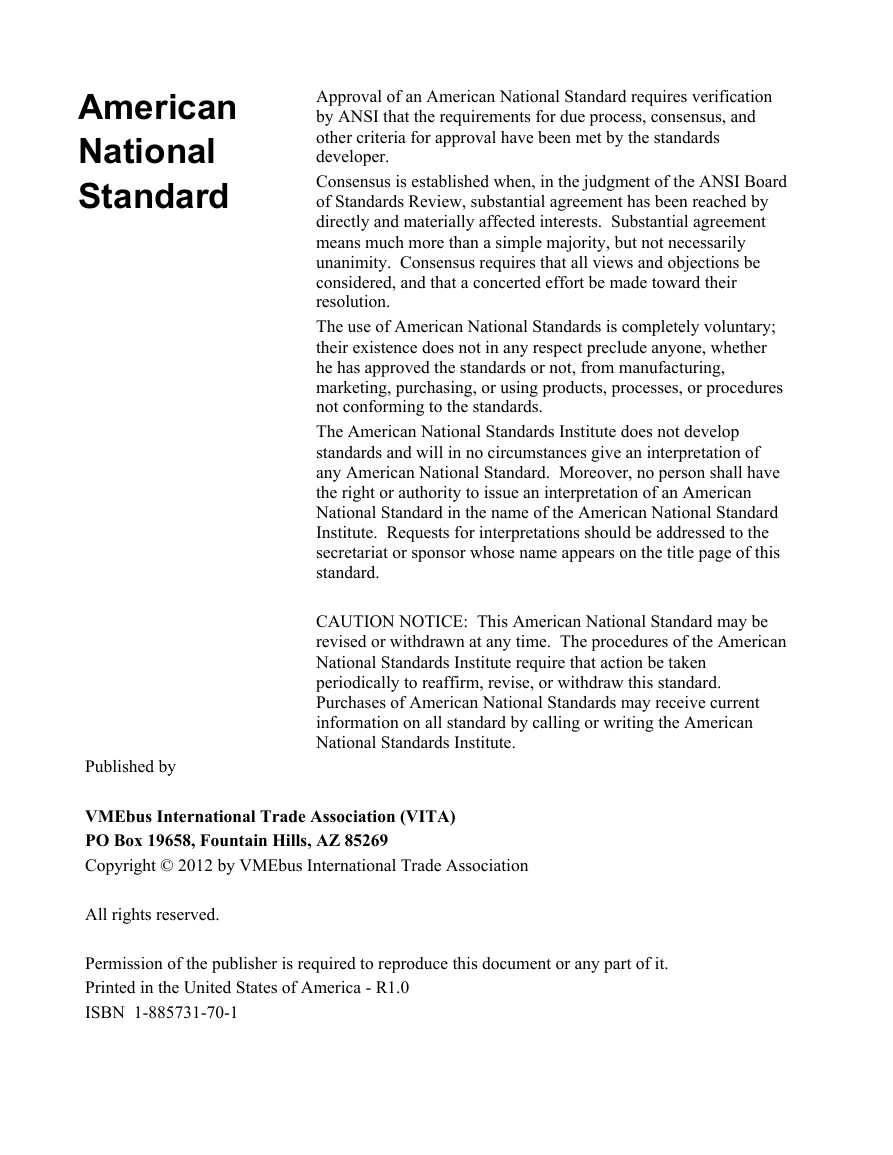
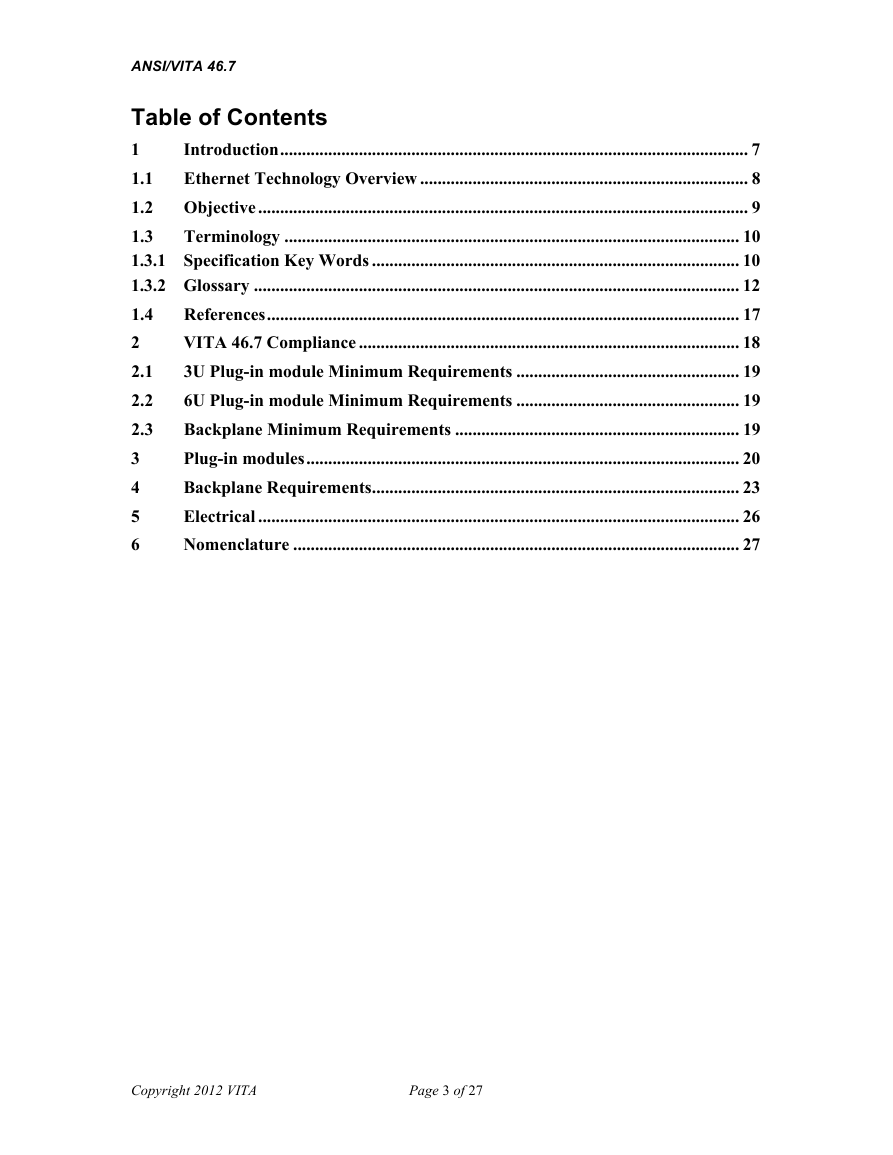

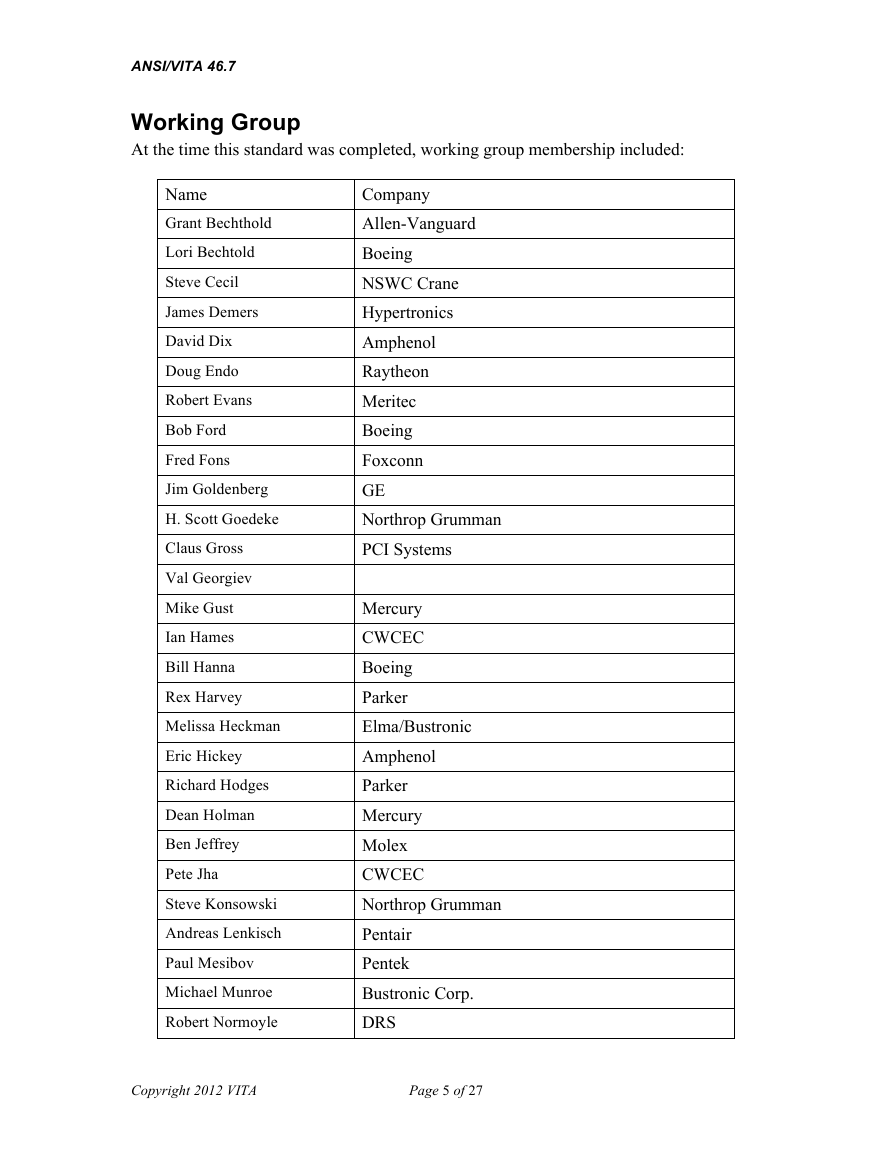

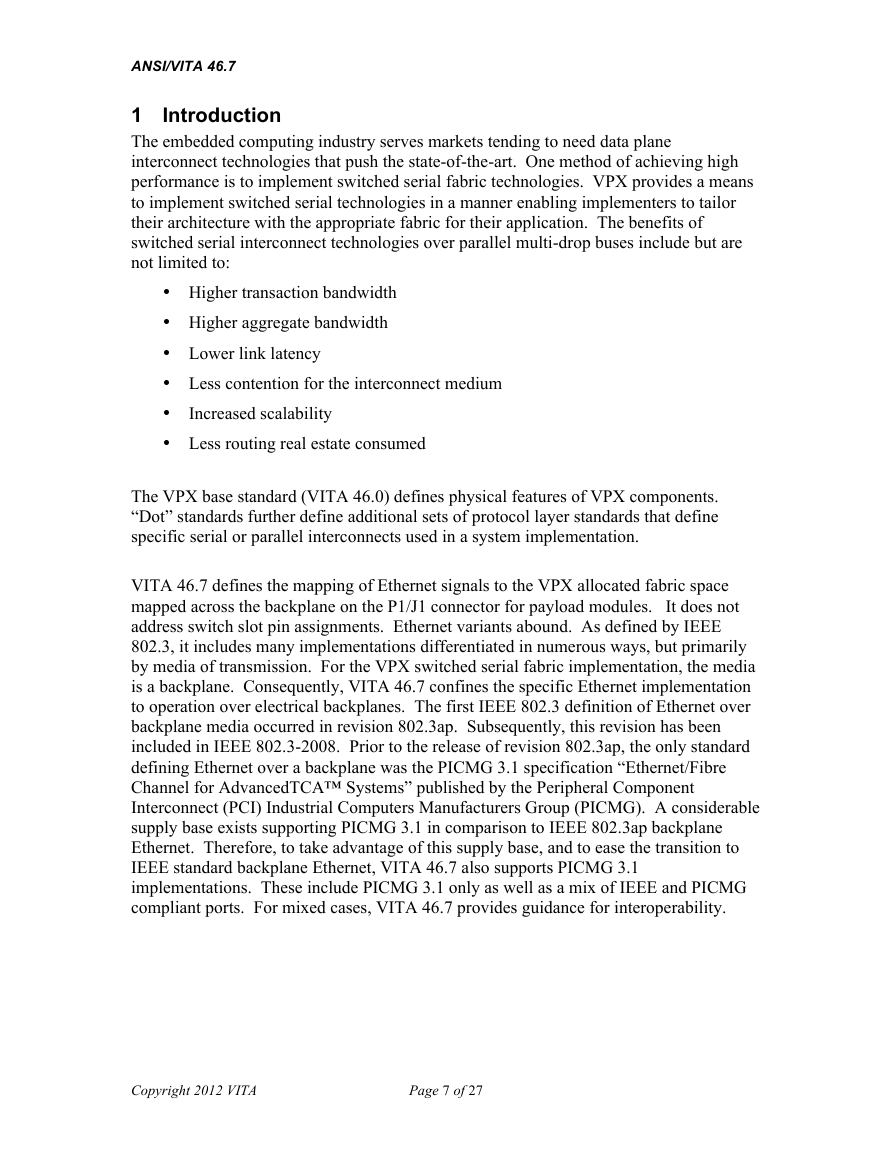
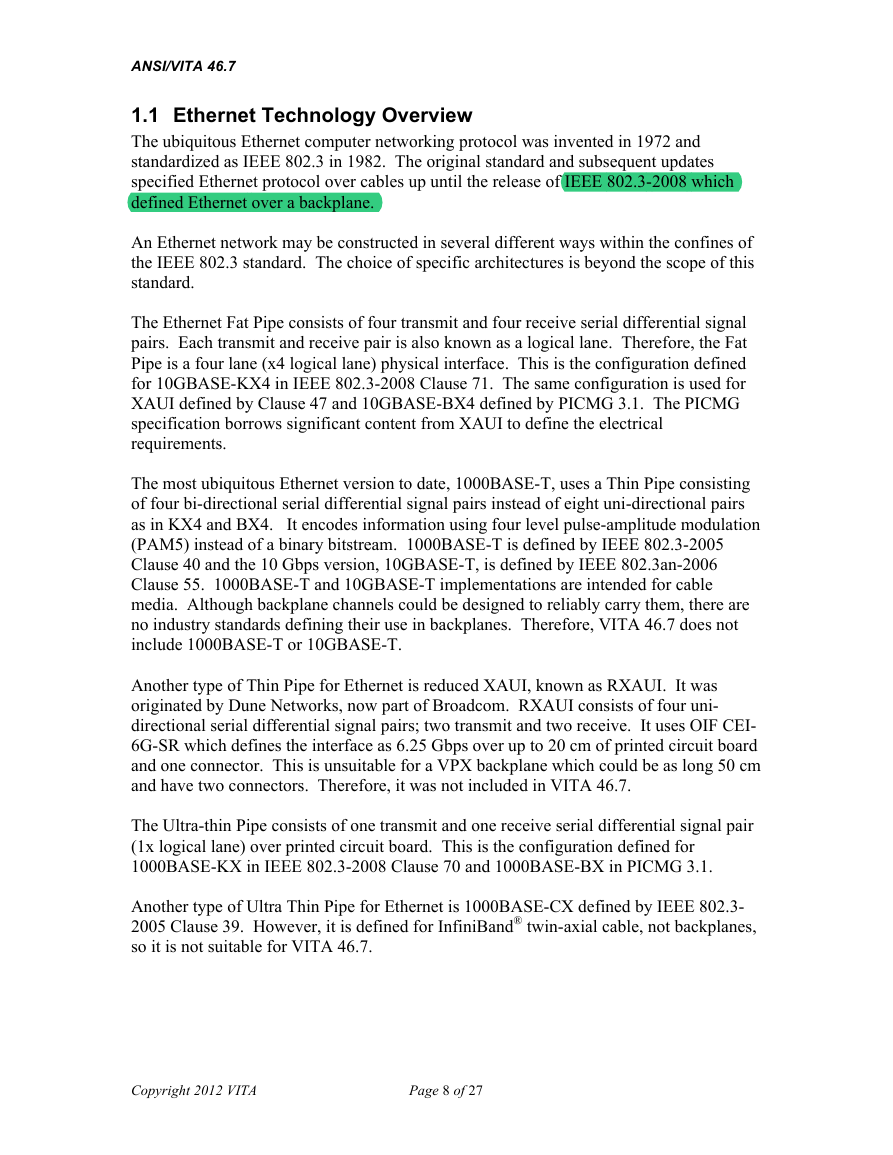








 2023年江西萍乡中考道德与法治真题及答案.doc
2023年江西萍乡中考道德与法治真题及答案.doc 2012年重庆南川中考生物真题及答案.doc
2012年重庆南川中考生物真题及答案.doc 2013年江西师范大学地理学综合及文艺理论基础考研真题.doc
2013年江西师范大学地理学综合及文艺理论基础考研真题.doc 2020年四川甘孜小升初语文真题及答案I卷.doc
2020年四川甘孜小升初语文真题及答案I卷.doc 2020年注册岩土工程师专业基础考试真题及答案.doc
2020年注册岩土工程师专业基础考试真题及答案.doc 2023-2024学年福建省厦门市九年级上学期数学月考试题及答案.doc
2023-2024学年福建省厦门市九年级上学期数学月考试题及答案.doc 2021-2022学年辽宁省沈阳市大东区九年级上学期语文期末试题及答案.doc
2021-2022学年辽宁省沈阳市大东区九年级上学期语文期末试题及答案.doc 2022-2023学年北京东城区初三第一学期物理期末试卷及答案.doc
2022-2023学年北京东城区初三第一学期物理期末试卷及答案.doc 2018上半年江西教师资格初中地理学科知识与教学能力真题及答案.doc
2018上半年江西教师资格初中地理学科知识与教学能力真题及答案.doc 2012年河北国家公务员申论考试真题及答案-省级.doc
2012年河北国家公务员申论考试真题及答案-省级.doc 2020-2021学年江苏省扬州市江都区邵樊片九年级上学期数学第一次质量检测试题及答案.doc
2020-2021学年江苏省扬州市江都区邵樊片九年级上学期数学第一次质量检测试题及答案.doc 2022下半年黑龙江教师资格证中学综合素质真题及答案.doc
2022下半年黑龙江教师资格证中学综合素质真题及答案.doc